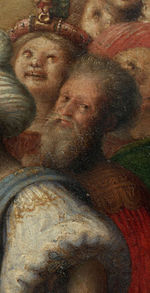Piero di Cosimo | |
|---|---|
 Presumed self-portrait at the right side of his painting Perseus Freeing Andromeda | |
| Born | 2 January 1462 |
| Died | 12 April 1522 (aged 60) |
| Nationality | Italian |
| Education | Cosimo Rosselli |
| Known for | Painting |
| Movement | High Renaissance |



Piero di Cosimo (2 January 1462[1] – 12 April 1522), also known as Piero di Lorenzo, was an Italian Renaissance painter, who continued to use an essentially Early Renaissance style into the 16th century.
He is most famous for the mythological and allegorical subjects he painted in the late Quattrocento; he is said to have abandoned these to return to religious subjects under the influence of Savonarola, the preacher who exercised a huge sway in Florence in the 1490s, and had a similar effect on Botticelli. The High Renaissance style of the new century had little influence on him, and he retained the straightforward realism of his figures, which combines with an often whimsical treatment of his subjects to create the distinctive mood of his works.
Vasari has many stories of his eccentricity, and the mythological subjects have an individual and quirky fascination.[2] He trained under Cosimo Rosselli, whose daughter he married, and assisted him in his Sistine Chapel frescos.
He was also influenced by Early Netherlandish painting, and busy landscapes feature in many works, often forests seen close at hand. Several of his most striking secular works are in the long "landscape" format used for paintings inset into cassone wedding chests or spalliera headboards or panelling. He was apparently famous for designing the temporary decorations for Carnival and other festivities.
- ^ After much uncertainty, Piero's birth date was identified in the parish records of San Lorenzo by Dennis Geronimus, "The Birth Date, Early Life, and Career of Piero di Cosimo", The Art Bulletin 82.1 (March 2000:164–170); Geronimus was able to rely on the consistency of Lorenzo di Piero d'Antonio's reports of his children's ages at the catasti of 1469 and 1480, and a new database of Florentine baptismal records.
- ^ Hartt, 480–481